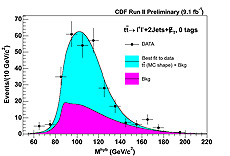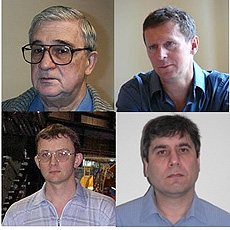Two neutrinos are a problem
 |
| The plot shows the fit to the dilepton data sample. The data are the points with error bars. The background (purple) and the signal plus the background (cyan) for the reconstructed top quark mass are normalized to the numbers returned by the fit. |
Nearly 30 years ago, the first pair of protons and antiprotons collided in the Tevatron. Ten years later the CDF and DZero experiments announced the discovery of the top quark, the heaviest known member of the Standard Model. Its mass, comparable to that of an atom of gold, is a fundamental parameter of the Standard Model. It contributes valuable information needed to constrain and to provide a consistency check of the Standard Model and must be measured experimentally. Recent theoretical developments may attach an even more important role of this Standard Model parameter — the fate of the universe. This is why the top quark continues to fascinate many physicists working on the Tevatron and LHC experiments.
At the Tevatron, top quarks were produced primarily in pairs, and each nearly always decayed into a bottom quark, producing b jet and a W boson. The W boson can decay in many ways, including into a pair of leptons (electron or muon) and its corresponding neutrino. Today's result, using the full CDF Run II data set, describes the final CDF measurement of the mass of the top quark for events in which both W bosons — one each from the top and the antitop quark — decay into leptons, the so-called dilepton channel. The mass measurements in this channel are not the most accurate. However they provide direct confirmation that the observed events are due to the Standard Model top quark. A significant discrepancy compared to measurements in other channels, namely the lepton-plus-jets and all-hadronic channels, could indicate new physics.
The dilepton channel features two main characteristics: a very low background and incomplete information on what exactly happened during the event, due to the two undetected neutrinos present in W decays.
The latter feature makes it impossible for scientists to fully reconstruct the event, meaning that we cannot accurately determine the jet energy. In other measurements of the top quark mass, specifically in which the W boson decays into two quarks instead of into a charged lepton and an undetected neutrino, the known W mass is used to improve our limited knowledge of jet energy in the event.
To try to overcome the problem of having limited information, CDF scientists developed a new optimal method for measuring the top quark mass in the dilepton channel. The method uses a "hybrid" variable sensitive to the true value of the top mass. The variable contains two parts: one that depends on the reconstructed top quark mass and one that depends on the mass constructed from complete knowledge of the leptons and the direction of the b jets. The second part does not depend on our limited knowledge of the jet's energy.
Mixing the weights of these two parts, CDF physicists can optimize the total uncertainty of the measurement.
With all improvements, the new method returns a value of the top quark mass of 171.46 ± 3.15 GeV/c2. The method improves the total measurement uncertainty by 15 percent compared to our older measurement, which used only the reconstructed mass. This is the most accurate value of the top quark mass obtained at the Tevatron in the dilepton channel without an external constraint of the jet energy scale from non-dilepton top-antitop events. Our measurement is consistent with the current world average, which includes our previous measurement in the dilepton channel: 173.34 ± 0.76 GeV/c2.
—edited by Andy Beretvas
Learn more
 |
| These scientists are the primary analysts for this result. Top row, from left: Julian Budagov and Vladimir Glagolev, both from JINR, Dubna. Second row, from left: Igor Suslov (JINR, Dubna) and George Velev (Fermilab). |
|